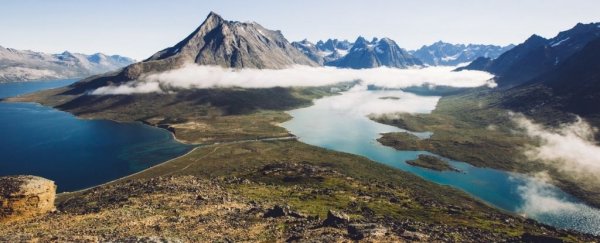Greenland's melting ice sheet is unleashing an astonishing amount of mercury into the nation's rivers and fjords.
Downstream of three glaciers in the southwest, researchers have found coastal ecosystems are swimming in high concentrations of the heavy metal, which can build up in the food web to toxic levels.
The quantity of mercury observed in three glacial rivers and three fjords in Greenland was among the worst in recorded history. In fact, researchers say the concentrations here are only matched by the polluted waterways of Industrial China, which overall produces about one-third of the world's mercury pollution.
As Greenland's glaciers continue to melt in line with our worst-case scenarios, experts are worried even more trapped mercury (Hg) could one day be released into the environment.
"This large, unaccounted for and climatically sensitive Hg source has not been considered in current global Hg budgets and Hg management strategies, but it should be assessed urgently given the human and economic implications of elevated Hg exposure," the authors of the new study warn.
Mercury is a natural and widespread element, released by wildfires, volcanic eruptions, and erosion. Yet in the past 150 years, industrial activity has been actively pumping even more of this pollutant into the atmosphere.
As the metal gradually drifts down from above, the element is passed from one organism to another, gradually concentrating in the food chain. People and animals in the Arctic are more likely to ingest toxic levels of mercury from their food and water, possibly because global circulation carries these heavy metals to the north.
In addition, increasing amounts of mercury also fall onto glaciers, snow, and ice, which can then run off into local waterways or rise into the atmosphere.
Previous studies have shown moderate mercury concentrations in run-off from melting glaciers, but the concentrations found in Greenland are two orders of magnitude higher than what scientists have found in other Arctic rivers.
"We didn't expect there would be anywhere near that amount of mercury in the glacial water there," says climate scientist Rob Spencer from Florida State University (FSU).
"Naturally, we have hypotheses as to what is leading to these high mercury concentrations, but these findings have raised a whole host of questions that we don't have the answers to yet."
Given the sheer amount of mercury discovered and the lack of major industry in the region, researchers think these high concentrations are probably not from industrial sources.
Instead, they might be coming from eroding rock underneath Greenland's ice sheet, which is naturally mercury-rich and is growing ever more exposed to the elements with climate change.
If the hunch is right, Greenland may very well be a neglected hotspot of natural mercury emissions, which have been trapped in ice for millennia. Even if we curb industrial mercury emissions tomorrow, the rapid melting of all this ice could sabotage human efforts to reduce pollution from this heavy metal to safe levels.
Already, experts think Greenland's ice sheet has reached a tipping point, with much of its ice doomed to melt. As glaciers disappear, revealing the bedrock underneath, preliminary research indicates atmospheric mercury could also increase.
"All the efforts to manage mercury thus far have come from the idea that the increasing concentrations we have been seeing across the Earth system come primarily from direct anthropogenic activity, like industry," explains environmental biogeochemist Jon Hawkings from FSU and the German Research Centre for Geosciences.
"But mercury coming from climatically sensitive environments like glaciers could be a source that is much more difficult to manage."
Given that Greenland is a major exporter of seafood, and the region is home to precious marine ecosystems, we'd best find out what's going on.
The study was published in Nature Geoscience.
